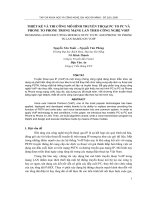Nghiên cứu và thi công mô hình phanh điện
Bạn đang xem bản rút gọn của tài liệu. Xem và tải ngay bản đầy đủ của tài liệu tại đây (7.56 MB, 25 trang )
HO CHI MINH CITY UNIVERSITY OF TECHNOLOGY AND EDUCATION
FACULTY OF VEHICLE AND ENERGY ENGINEERING
SUBJECT:
BACHELOR THESIS
TOPIC:
Researching about electro-mechanical
braking system and making a model.
Advisor’s name : NGUYEN VAN TOAN, MSc
Students’ name:
Student ID:
VO VAN THANH
13145234
NGUYEN THANH VU
13145332
•1
Content
Introduction
Overview
EWB
The pros
and cons
Operating Principle
Applications
Model
•2
Researching the theory
OBJECTIVE
Providing more information
Applying to make a model
•3
“The braking system of the coach which caused the
accident on Prenn Pass was not qualified”
•4
Brake and Anti-brake forces
•5
Evaluation of brake quality
•6
What types of brake in automobiles do you know ?
•7
Types of brake
NOISE
LOW EFFICIENCY
•8
Hydraulic brakes
USELESS
LEAKAGE
GET
RUINED
•9
Mechanical Brakes
HEAT
FRICTION
WEAR
DOWN
LOCK
•10
Anti-lock Brakes
Created to assist previous braking systems to
prevent the brakes from locking up while in use.
ABS works by sensing when a lock is about to
occur.
•11
ELECTRONIC WEDGE BRAKE SYSTEM
1. EMB wheel modules
2. Brake pedal feel
emulator
3. Wheel speed sensor
4. Central control unit
5. Yaw rate and lateral
acceleration sensors
6. Parking brake switch
•12
Comparison of components
•13
The Electronic Wedge Brake
•14
Components
•15
Normal power
F
•16
Wedge power
Operating principle
A brake pad connected to a wedge is
pressed between the rod and the disc
through the use of electric motors.
The electric motors turn and push the
pad onto the disc.
•17
Sensors measuring wheel speed about
a hundred times per second can adjust
brake forces and wedge position to a
high degree of accuracy.
Controlling Principle & H-Bridge
•18
High Performance
•19
The pros and cons
A fully controlled electro-mechanical
braking system, self-reinforcement.
Intelligently controlling the wedge
The pros
A significant reduction in the actuator’s
energy demand.
Energy consumption, efficiency,
weight…
•20
The deformation of the brake caliper in
automobiles.
The cons
Complex control
High price.
•21
Applications
•22
Model
Structure
Operating principle
Arduino Controlling principle
In conclusion
•23
Algorithm diagram
•24
Thank you so much for attending.
•25









